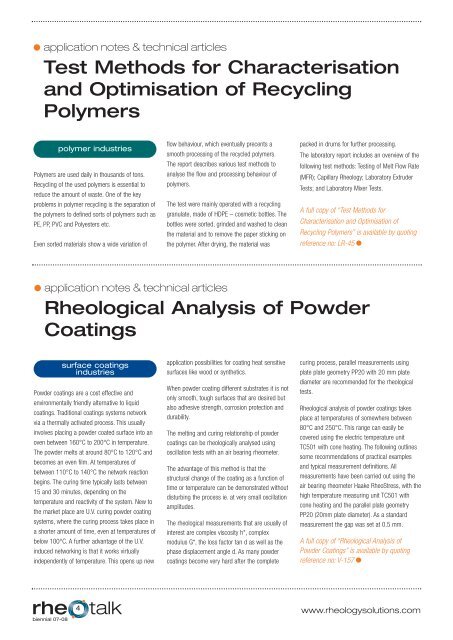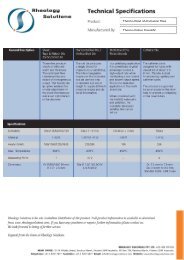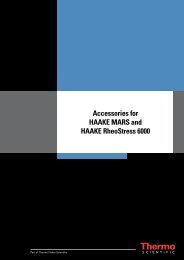Download - Rheology Solutions
Download - Rheology Solutions
Download - Rheology Solutions
Create successful ePaper yourself
Turn your PDF publications into a flip-book with our unique Google optimized e-Paper software.
application notes & technical articles<br />
Test Methods for Characterisation<br />
and Optimisation of Recycling<br />
Polymers<br />
Polymers are used daily in thousands of tons.<br />
Recycling of the used polymers is essential to<br />
reduce the amount of waste. One of the key<br />
problems in polymer recycling is the separation of<br />
the polymers to defined sorts of polymers such as<br />
PE, PP, PVC and Polyesters etc.<br />
Even sorted materials show a wide variation of<br />
biennial 07-08<br />
polymer industries<br />
Powder coatings are a cost effective and<br />
environmentally friendly alternative to liquid<br />
coatings. Traditional coatings systems network<br />
via a thermally activated process. This usually<br />
involves placing a powder coated surface into an<br />
oven between 160°C to 200°C in temperature.<br />
The powder melts at around 80°C to 120°C and<br />
becomes an even film. At temperatures of<br />
between 110°C to 140°C the network reaction<br />
begins. The curing time typically lasts between<br />
15 and 30 minutes, depending on the<br />
temperature and reactivity of the system. New to<br />
the market place are U.V. curing powder coating<br />
systems, where the curing process takes place in<br />
a shorter amount of time, even at temperatures of<br />
below 100°C. A further advantage of the U.V.<br />
induced networking is that it works virtually<br />
independently of temperature. This opens up new<br />
flow behaviour, which eventually precents a<br />
smooth processing of the recycled polymers.<br />
The report describes various test methods to<br />
analyse the flow and processing behaviour of<br />
polymers.<br />
The test were mainly operated with a recycling<br />
granulate, made of HDPE – cosmetic bottles. The<br />
bottles were sorted, grinded and washed to clean<br />
the material and to remove the paper sticking on<br />
the polymer. After drying, the material was<br />
application possibilities for coating heat sensitive<br />
surfaces like wood or synthetics.<br />
When powder coating different substrates it is not<br />
only smooth, tough surfaces that are desired but<br />
also adhesive strength, corrosion protection and<br />
durability.<br />
The melting and curing relationship of powder<br />
coatings can be rheologically analysed using<br />
oscillation tests with an air bearing rheometer.<br />
The advantage of this method is that the<br />
structural change of the coating as a function of<br />
time or temperature can be demonstrated without<br />
disturbing the process ie. at very small oscillation<br />
amplitudes.<br />
The rheological measurements that are usually of<br />
interest are complex viscosity h*, complex<br />
modulus G*, the loss factor tan d as well as the<br />
phase displacement angle d. As many powder<br />
coatings become very hard after the complete<br />
packed in drums for further processing.<br />
The laboratory report includes an overview of the<br />
following test methods: Testing of Melt Flow Rate<br />
(MFR); Capillary <strong>Rheology</strong>; Laboratory Extruder<br />
Tests; and Laboratory Mixer Tests.<br />
A full copy of “Test Methods for<br />
Characterisation and Optimisation of<br />
Recycling Polymers” is available by quoting<br />
reference no: LR-45<br />
application notes & technical articles<br />
Rheological Analysis of Powder<br />
Coatings<br />
surface coatings<br />
industries<br />
curing process, parallel measurements using<br />
plate plate geometry PP20 with 20 mm plate<br />
diameter are recommended for the rheological<br />
tests.<br />
Rheological analysis of powder coatings takes<br />
place at temperatures of somewhere between<br />
80°C and 250°C. This range can easily be<br />
covered using the electric temperature unit<br />
TC501 with cone heating. The following outlines<br />
some recommendations of practical examples<br />
and typical measurement definitions. All<br />
measurements have been carried out using the<br />
air bearing rheometer Haake RheoStress, with the<br />
high temperature measuring unit TC501 with<br />
cone heating and the parallel plate geometry<br />
PP20 (20mm plate diameter). As a standard<br />
measurement the gap was set at 0.5 mm.<br />
A full copy of “Rheological Analysis of<br />
Powder Coatings” is available by quoting<br />
reference no: V-157<br />
4 www.rheologysolutions.com










